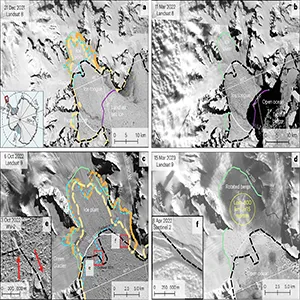
Fastest glacier collapse in history was recently recorded in Antarctica
A glacier on the eastern Antarctic Peninsula has just broken speed records. In late 2022, Hektoria Glacier retreated about five miles (8 kilometers) in just two months, making it the fastest known modern collapse of any grounded Antarctic glacier.
Researchers traced the event to a simple setup beneath the ice. A flat seabed let the glacier become briefly buoyant, then break apart in large slabs. A new study reports the retreat peaked at roughly half a mile per day in November and December 2022.
The work was led by Naomi Ochwat, a postdoctoral researcher at the Cooperative Institute for Research in Environmental Sciences at the University of Colorado Boulder (CIRES).
“When we flew over Hektoria in early 2024, I couldn’t believe the vastness of the area that had collapsed,” she said.
“If we only had one image every three months, we might not be able to tell you that the glacier lost two and a half kilometers (1.6 miles) in two days.”
Triggering Hektoria glacier collapse
An ice plain – a flat bed below sea level where ice is only lightly grounded – can leave a glacier just one thinning step from flotation. An earlier paper documented this kind of lightly grounded zone elsewhere in Antarctica.
The grounding line, the point where a glacier stops touching the seafloor, can shift quickly with thinning or tides. A clear explanation shows why that zone controls stability.
Once Hektoria thinned enough to float across its ice plain, gravity and buoyancy did the rest. The result was buoyancy-driven calving – a breakup caused by flotation forces – that toppled thick blocks forward and cleared the front.
Six glacial earthquakes coincided with the largest breakups, a known signal of capsizing icebergs at fast-calving fronts. That pattern matches prior work linking long-period seismic events to mile-scale iceberg capsizes.
Hektoria glacier collapse from space
Satellites tracked a sixfold jump in flow speed as the front destabilized. Laser altimetry showed dramatic thinning, reaching about 262 feet (80 meters) per year on the remaining ice.
The loss did not depend on unusually warm ocean water or surface melt at the time of peak retreat. It followed the removal of local fast ice. This seasonal plate had been damping waves and holding a loose pack of bergs tight.
Back in 2002, a different kind of support vanished when the nearby Larsen B Ice Shelf collapsed, after which tributary glaciers sped up and thinned. That response was captured in a landmark analysis that helped scientists connect shelf loss to faster flow.
Seismic stations clinched the state of the ice during the burst of retreat. Forceful signals indicated the front was grounded as it fractured, which means the lost ice directly raised sea level rather than just shifting floaters.
Why this matters for sea levels
Hektoria is not huge by Antarctic standards, but its setup is common. Ice plains appear beneath several major outlets in Antarctica.
Paleoclimate mapping shows that when grounding lines sit on very flat beds, retreats can pulse far faster than most modern records.
One article reported past grounding line rates between 180 and 2,000 feet (55 to 610 meters) per day on flat seafloors.
Speed is the risk multiplier. If similar geometry exists under larger glaciers, short bursts could rapidly remove grounded ice and add to sea level before models expect it.
“If the same conditions set up in some of the other areas, it could greatly speed up sea level rise from the continent,” said Ted Scambos, the CIRES senior research scientist and coauthor.

Mapping the next risks
Future research now aims to locate other Antarctic glaciers sitting on similar flat beds. Scientists are using radar, seismic data, and satellite altimetry to map where ice plains are likely hiding beneath the continent’s ice sheet.
These areas are early-warning zones, where a few feet of thinning could cause glaciers to lift off the seafloor and break apart like Hektoria did.
Climate models also need to catch up to this new understanding. Most global projections treat glacier retreat as a steady process, not one that can accelerate tenfold once flotation begins.
Including these sudden buoyancy events could shift timelines for future sea-level rise by decades, especially for West Antarctic ice streams already near the tipping point.
Lessons from Hektoria glacier collapse
Two questions now matter most. First, where else the bed remains flat for long distances beneath thinning ice.
Second, how quickly local sea ice and mélange return – or vanish. Ice mélange, a jumbled mix of icebergs and sea ice, adds backstress at the glacier front, but when it clears out, the front can fail much faster.
This event also sharpens what glacier models must include. Models should allow for sudden flotation on ice plains, forward toppling of thick slabs, and short-lived surges in motion.
That is not sensational – it is a straightforward update to how a glacier collapses when the bed gives them a lift.
The study is published in Nature Geoscience.
—–
Like what you read? Subscribe to our newsletter for engaging articles, exclusive content, and the latest updates.
Check us out on EarthSnap, a free app brought to you by Eric Ralls and Earth.com.
—–













